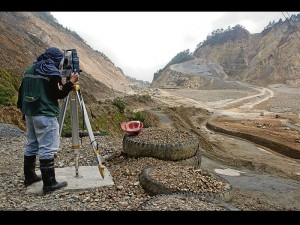Mine spill fine too low? Don’t look at us–Philex

A miner monitors quarrying operations at Philex Mining’s old open pit mine in Benguet. The P1-billion penalty paid by Philex Mining for the tailings spill that occurred at its Padcal mine site in August 2012 may have been “low,” according to Sen. Sergio Osmeña III. INQUIRER FILE PHOTO
MANILA, Philippines—The P1-billion penalty paid by Philex Mining Corp. for the tailings spill that occurred at its Padcal mine site in August 2012 may have been “low,” according to Sen. Sergio Osmeña III.
“I have suspicions that it was undervalued,” said Osmeña, vice chairman of the Senate environment committee, after the panel’s initial hearing on Tuesday.
The senator, on whose privilege speech the Senate probe was based, said people he knew in the mining industry had told him that relative to the volume of the spill, P1 billion was very low.
“We will try to compute how (the authorities pegged the penalty) at P1 billion. I don’t know but, just very recently, I had talks with people connected to the mining industry who told me that P1 billion, which is only about $25 million, is certainly a very, very low amount for an almost 21-million-metric-ton spill,” he told reporters outside the hearing room.
There was a need to “clarify mining policies” following the accident, he said.
Pressed to explain, Osmeña said that had the accident occurred in another country, Philex could have been made to pay as much as $1 billion (P40 billion).
“Most of the time, I tend to discover that our fines are so low for many crimes. Napakaliit (Very small),” he said.
Osmeña said the proper amount would have to be computed based on Philex’s ability to pay.
‘Make sure it hurts’
“Let’s see…the total revenues of Philex are not that big so ($1 billion) would not be realistic. But when you impose a fine, make sure it hurts so the [payee] is forced to implement preventive measures. If a company were to be penalized P5 billion, its people could consider spending P500 million to ensure that an accident would not happen,” he said.
Told of Osmeña’s remarks, Philex senior vice president for corporate affairs Mike Toledo said it was the Mines and Geosciences Bureau (MGB) that imposed the P1-billion fine and the mining firm had already paid it.
At the Senate hearing, Environment Secretary Ramon Paje recalled that the MGB immediately issued a suspension order “on the entire operation” of Philex the day after the 21-million-metric-ton spill occurred on Aug. 1, 2012.
After another spill occurred on Aug. 3, Paje said the MGB conducted a probe that showed that “at least five million cubic meters of sediments” was discharged and contaminated a 2.5-kilometer stretch of the Balog River.
Paje said a multidisciplinary committee was formed to determine the liabilities and penalties against Philex. A report that the committee submitted one month later showed that the total volume of mine tailings that leaked from the Padcal mine measured 13.513 cubic meters, equivalent to 20,689,179.42 tons.
More precautions
Philex was found liable and fined P1.034 billion based on the Philippine Mining Act.
Paje said that Philex should have conducted more safety inspections apart from the one it regularly does during the summer.
For his part, Philex president Eulalio Austin said company procedures dictate that the inspection of penstocks discharges to the river is done in the dry season to prevent accidents that could occur when it rains.
Philex consultants and other officers took turns assuring the Senate committee that more precautions were being put in place to prevent a recurrence of the August accident.
Toledo said the MGB and the Pollution Adjudication Board of the Department of Environment and Natural Resources “have already given their separate go-signals to the company to resume temporary operations for four months.”
He said Philex was using the time to complete a P2-billion “beaching process…meant to fortify” the portion of the mine damaged by heavy rains when the accident occurred.
Toledo stressed that the accident was a force majeure as “it was a result of the elements of nature…But even as we were not at fault, we share the concern of the government for the environment, thus we are paying the fee, as set by regulators, to cover the costs of remediation and rehabilitation activities.”
